Preamble: It is a privilege for us to republish, with the author’s permission, the following article initially posted on the blog The Unwashed Brain. The original can be found here. Please keep a lookout for future publications by the author to be featured on Slavyangrad.org. They deserve to be read thoughtfully and with care and are an important addition to the discourse of the Ukrainian Civil War.
Faking pictures can backfire badly if you’re caught. A government will only risk it when the stakes are high, the risks are low, and there’s no other evidence it can use.
The best example is the notorious ‘Russian Soldier’ image, which the Kiev government proudly presented to John Kerry as the long-sought evidence of Russian’s military involvement in Ukraine. It inspired massive headlines in all the western media, and was only exposed as a fake when the central picture turned out to be stolen from the Instagram account of photographer Maxim Dondyuk – where it was clearly labelled ‘Slavyansk’ and not ‘Georgia’.
 We may laugh now, but the hoax isn’t quite as stupid as it seems. Precautions had been taken against exposure, and those amateurish red and yellow rings served as cunning camouflage in any image search, where Google naturally interpreted them as an integral part of the picture. If it hadn’t been for a sophisticated image-identifier from Tineye, Kiev would probably have got away with it and NATO might have been in Ukraine before May.
We may laugh now, but the hoax isn’t quite as stupid as it seems. Precautions had been taken against exposure, and those amateurish red and yellow rings served as cunning camouflage in any image search, where Google naturally interpreted them as an integral part of the picture. If it hadn’t been for a sophisticated image-identifier from Tineye, Kiev would probably have got away with it and NATO might have been in Ukraine before May.
Even exposure didn’t cost Kiev much. The western media protected them, the NYT’s ambiguous retraction was buried deep on page 9, and many people still believe the ‘little green men’ were definitely identified as Russian soldiers. Kiev lost little, gained much, and proved how effective such fakes could really be.
But there’s a different kind of fake washing round the internet at the moment – one where the stakes are low, the risks astronomically high, and where the effects on the supposed creator can only be damaging. You know the things – those simple unmarked pictures of Ukrainian atrocities which circulate for a couple of days before being triumphantly exposed by Kiev’s INFORESIST as ‘retreads’ from Syria, Bosnia or Palestine. Indeed, there are now so many that US government employee Julia Davis is show-casing them all in a long-running series entitled Russia’s Top 40/60/80 Lies on Ukraine.
 Because obviously they must be Russia’s lies. Who else? Only Russia wants to highlight the civilian cost of Kiev’s ATO, so only Russia would bother faking pictures to prove it.
Because obviously they must be Russia’s lies. Who else? Only Russia wants to highlight the civilian cost of Kiev’s ATO, so only Russia would bother faking pictures to prove it.
Except that it doesn’t need to. Graphic material like this from Lugansk and Slavyansk contain countless powerful images to illustrate the horror of Kiev’s ATO, so why would they fake something they can already prove? I don’t want to be brutal about it, but why on earth would anyone illustrate street violence with a fake photograph like this:
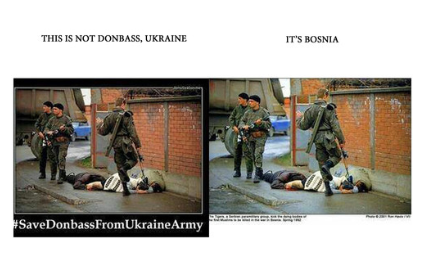 when they could link to a video of a man having his leg cut off on the streets of Odessa?
when they could link to a video of a man having his leg cut off on the streets of Odessa?
Why would they bother to fake this picture of a distressed child:
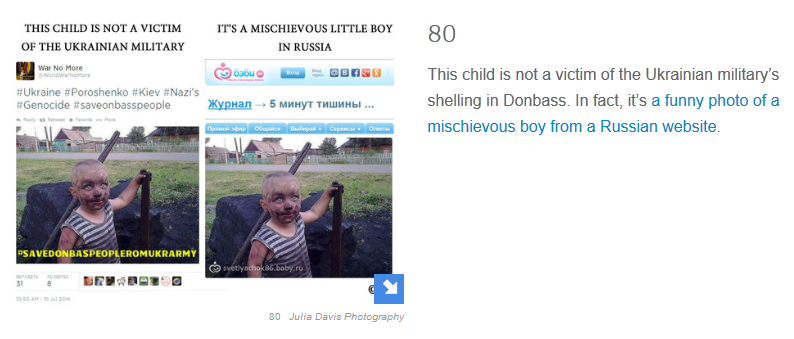 when they could share the story of five year old Arseny Danchenko, who died in Slavyansk with more than 309 shrapnel wounds in his head?
when they could share the story of five year old Arseny Danchenko, who died in Slavyansk with more than 309 shrapnel wounds in his head?
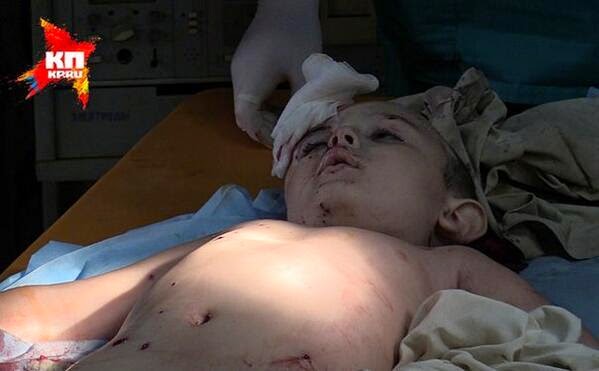 or show the funeral of 10-month old Igor Aleksandrov who was killed in the shelling of Lugansk?
or show the funeral of 10-month old Igor Aleksandrov who was killed in the shelling of Lugansk?
 Indeed, I’d ask why we’d need to ‘steal’ ANY other images of bombing victims, when nothing can match the heart-wrenching eloquence of this image of Inna Kudurudza, taken in the very last minutes of her life?
Indeed, I’d ask why we’d need to ‘steal’ ANY other images of bombing victims, when nothing can match the heart-wrenching eloquence of this image of Inna Kudurudza, taken in the very last minutes of her life?
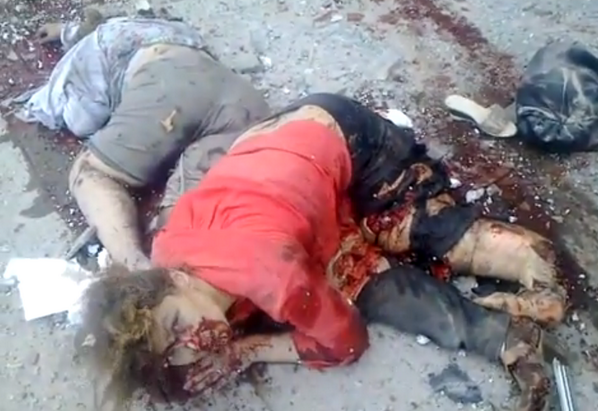 The truth is that those of us who care about Donbass people already have enough images of horror to keep us from sleep for the rest of our lives. WE DO NOT NEED TO FAKE ANY MORE.
The truth is that those of us who care about Donbass people already have enough images of horror to keep us from sleep for the rest of our lives. WE DO NOT NEED TO FAKE ANY MORE.
Nor does it make any sense to do so, when Russia has everything to lose by circulating these fakes, and absolutely nothing to gain. If we stand back and look at this objectively, it’s obvious that the only winners in this fake game are those who wish to discredit Russia and the people of East Ukraine.
There’s nothing new in that idea. Plant a lie, wait for your opponent to repeat it in good faith – then call him out for being a liar. Doing it with pictures is an old game, and an example from the UK shows its benefits are very real. In September 2003 the country was shaken by revelations that British soldiers had been abusing Iraqi prisoners, and the public mood began to swing dangerously against both government and war. Outrage rose to a climax in January 2004 when the Daily Mirror published disgusting pictures to prove even more abuses – only to collapse a few days later when the anonymously-supplied pictures were revealed to be fake. The backlash was fierce, and in the subsequent publicity the public’s original concerns faded and died. No-one knows who planted those fake photographs at the Mirror, but there’s no doubt at all who benefited.
There’s no doubt in Ukraine either. The public are now so used to fake pictures that they ignore even the real ones – except to question their authenticity. I recently posted this picture to someone on Twitter who seemed to think the only people dying were ‘terrorists’, but her immediate response was simply ‘That picture is not in Ukraine’.
 Well it is, actually. That’s the last picture of tragic six-year old Pollina Sladkaya, who was shelled in Slavyansk by the Ukrainian army and died in her father’s arms. It’s not a fake, it doesn’t appear on any debunking sites, but my correspondent didn’t even bother to check before trashing it. Somewhere in her head is the equation ‘Picture of Human Suffering in East Ukraine = Fake’, and until that’s dispelled she’ll never understand that the people being killed out there are not terrorists.
Well it is, actually. That’s the last picture of tragic six-year old Pollina Sladkaya, who was shelled in Slavyansk by the Ukrainian army and died in her father’s arms. It’s not a fake, it doesn’t appear on any debunking sites, but my correspondent didn’t even bother to check before trashing it. Somewhere in her head is the equation ‘Picture of Human Suffering in East Ukraine = Fake’, and until that’s dispelled she’ll never understand that the people being killed out there are not terrorists.
Which is, of course, precisely the desired result. There are even people on Twitter whose job is to encourage it, such as the ironically named @grasswirefacts who posts ridiculous lies like this one:
 I can understand why he’d want to discredit this photo. It’s not only a heartbreaking image in its own right, but also has the added poignancy of being one of the last pictures taken by Italian photographer Andrea Rocchelli before he was killed by the Ukrainian army on May 25th. It’s also extremely easy to authenticate from his published portfolio, but @grasswirefacts wasn’t interested in truth so much as propaganda, and no fewer than 20 people retweeted the lie before he was forced to delete it.
I can understand why he’d want to discredit this photo. It’s not only a heartbreaking image in its own right, but also has the added poignancy of being one of the last pictures taken by Italian photographer Andrea Rocchelli before he was killed by the Ukrainian army on May 25th. It’s also extremely easy to authenticate from his published portfolio, but @grasswirefacts wasn’t interested in truth so much as propaganda, and no fewer than 20 people retweeted the lie before he was forced to delete it.
Damaging enough, but the effects can be even wider than that. Fake pictures are like rotten apples, and just one in a collection is enough to damn the whole lot. Probably the most popular (and therefore most dangerous) fakes in circulation are these beautiful pictures of children, of which the first is a still from the Russian film ‘The Brest Fortress‘, and the second is a 2010 photograph of a grieving father in Crimea.
 They’ve been around so long it would take months to trace them back to the first lethal ‘fakery’, but they’re both beautiful pictures and it’s hardly surprising so many people have used them in good faith since. The tragedy is that organizations like ‘Save Donbass People’ have now used them in videos and posters, with the terrible effect of contaminating their whole campaign. I was at a rally a few weeks ago where a woman had created a really wonderful photo-collage for a banner – but smack in the middle was that Brest Fortress child, and it rendered the whole lot useless. She was devastated when I told her, as most of us would be. What Kiev propagandists pretend not to realize is that the liars are the people who create the fakes in the first place – not those who subsequently employ them in all innocence.
They’ve been around so long it would take months to trace them back to the first lethal ‘fakery’, but they’re both beautiful pictures and it’s hardly surprising so many people have used them in good faith since. The tragedy is that organizations like ‘Save Donbass People’ have now used them in videos and posters, with the terrible effect of contaminating their whole campaign. I was at a rally a few weeks ago where a woman had created a really wonderful photo-collage for a banner – but smack in the middle was that Brest Fortress child, and it rendered the whole lot useless. She was devastated when I told her, as most of us would be. What Kiev propagandists pretend not to realize is that the liars are the people who create the fakes in the first place – not those who subsequently employ them in all innocence.
But there’s another danger too, and these ‘plants’ are now being used to discredit more than casualties. On July 11th the ARES confirmed that Kiev was using cluster bombs against civilians, and published the photographs to prove it.
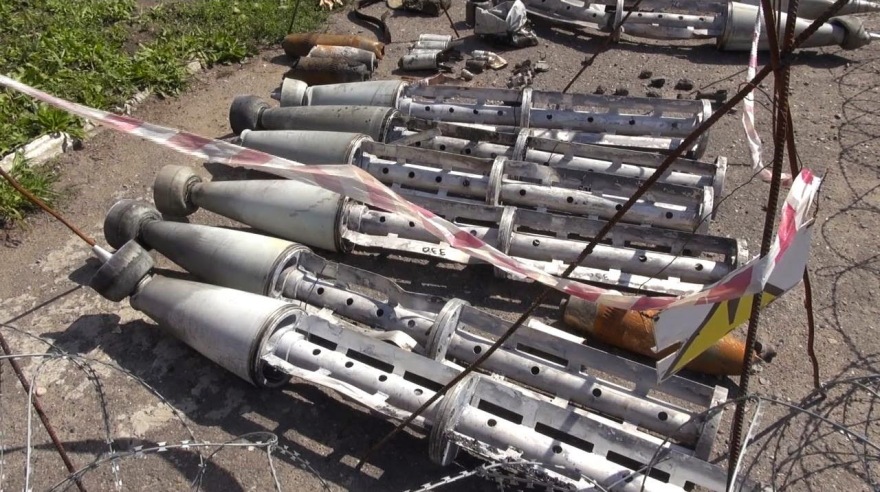 Devastating stuff, but the news was ignored in the media and met little response even on Twitter.
Devastating stuff, but the news was ignored in the media and met little response even on Twitter.
Because of this:
 It’s an AP file photo of a cluster bomb in Lebanon taken back in 2006, which began to appear on Twitter as a Ukraine fake as early as May. It was ‘picked up’ immediately by the debunkers, and by the time the real photographs came along the public hardly even bothered to click on the links. ‘Cluster bombs? Seen that, it’s fake.’ That one planted picture is responsible for smothering direct, independent evidence of Ukraine’s breach of Article 3 of the Geneva Conventions – which is a war crime.
It’s an AP file photo of a cluster bomb in Lebanon taken back in 2006, which began to appear on Twitter as a Ukraine fake as early as May. It was ‘picked up’ immediately by the debunkers, and by the time the real photographs came along the public hardly even bothered to click on the links. ‘Cluster bombs? Seen that, it’s fake.’ That one planted picture is responsible for smothering direct, independent evidence of Ukraine’s breach of Article 3 of the Geneva Conventions – which is a war crime.
But can we really be sure it was a plant? The ‘cui bono?’ principle may make it the likeliest explanation, but isn’t it at least possible that these are genuine fakes, produced by a ‘pro-Russian’ activist so subhumanly unintelligent that he didn’t realize his chances of getting away with it were approximately nil?
The honest answer is that anything’s possible, but there are three other good indications that these are the work of someone hostile to the anti-Kiev cause. These are:
1. The Content
As the examples above show, most of these plants are so much milder than the real thing that it wouldn’t be worth anyone’s time to fake them. I don’t want to post too many disturbing pictures on this blog, but you can find a very grim selection of real images here from Odessa, for instance, or here on the July 2nd massacre at Stanichno and Kondraševka.
2. The obviousness
There’s no attempt to hide the origins of these pictures, no ‘marking’ like the rings on the ‘Fake Russian Soldier’. They aren’t even obscure images, but pictures so well known they’re likely to come up first on a Google search. Some even verge on the ridiculous, and seem almost to be screaming ‘FAKE’ in the viewer’s ear.
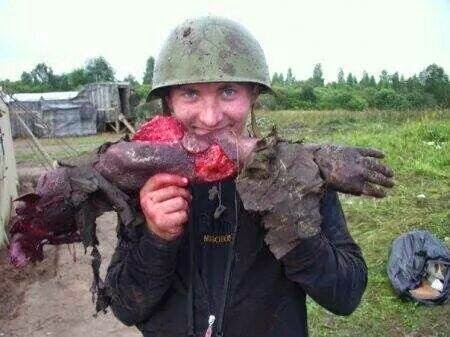 It’s hard to avoid the conclusion that whoever’s planting these images actually WANTS them to be exposed.
It’s hard to avoid the conclusion that whoever’s planting these images actually WANTS them to be exposed.
3. The mysteriousness of the source.
The ‘Fake Russian Soldier’ was presented openly by the Kiev government, but the origins of these are as murky as the hoax photos in the Daily Mirror. Some may be posted in good faith by recognized ‘pro-Russians’ on Twitter, but I’ve never known one actually start there, and they’re as hard to trace as rumours. The people ‘seeding’ these pictures may want them exposed as fakes – but they don’t want anyone to know who’s doing the faking.
And we don’t know – not for sure. We can only be certain that whoever’s planting these things is supportive of the US/Ukraine cause and doing all they can to discredit genuine evidence of Kiev’s crimes.
Those of us who care about truth will want to do all we can to prevent the spread of this disinformation, and there are a few precautions we can take. The first is to avoid ‘picking up’ these plants in the first place, which means watching out for where these things start and learning what to avoid. Most seem to start life on Instagram before being posted anonymously to veooz, LiveLeak, ‘breaking news’ sites or ‘pro-Russian’ discussion forums – anywhere anti-Kiev activists are most likely to visit.
Here’s one example:
 The anonymous poster is so anxious to reach a wider audience that he offers his story in both English and Italian, and begs everyone who reads it to ‘share’ – but the image is from Syria, and the text contains a few clues that should give us pause.
The anonymous poster is so anxious to reach a wider audience that he offers his story in both English and Italian, and begs everyone who reads it to ‘share’ – but the image is from Syria, and the text contains a few clues that should give us pause.
 This sentence: This child was severely injured by a superdemocratic and supereuropean maidanite bomb. This is incredibly sophisticated word-play for a non-native English speaker, and quite incompatible with the poor spelling and awkward phrasing of ‘I reproduce here his words’. That combined with the double use of ‘kid’ makes me suspect the writer of actually being American.
This sentence: This child was severely injured by a superdemocratic and supereuropean maidanite bomb. This is incredibly sophisticated word-play for a non-native English speaker, and quite incompatible with the poor spelling and awkward phrasing of ‘I reproduce here his words’. That combined with the double use of ‘kid’ makes me suspect the writer of actually being American.
But it isn’t always this easy, and one fake turned out to have its origins in the place we’d probably be least likely to suspect. It’s this little gem from the eagle-eyed Julia Davis, who denounces Russia for supporting its ‘lies’ with a picture of refugees from Kosovo.
 Ms Davis’ source is clearly the debunk given here, but when I looked at the Russian article in the link I found there was no actual lie at all – the picture is simply captioned ‘Refugees’, in the same way editors include a generic picture of a gun above a story about a shooting.
Ms Davis’ source is clearly the debunk given here, but when I looked at the Russian article in the link I found there was no actual lie at all – the picture is simply captioned ‘Refugees’, in the same way editors include a generic picture of a gun above a story about a shooting.
 To be fair, it’s still misleading, and it’s possible another version (since deleted) had been even more direct. I suspected RIA Novosti had fallen victim to a ‘plant’, and looked for anything published earlier than 5th June that might give us the source.
To be fair, it’s still misleading, and it’s possible another version (since deleted) had been even more direct. I suspected RIA Novosti had fallen victim to a ‘plant’, and looked for anything published earlier than 5th June that might give us the source.
And found it. This one’s a lie all right, but what Julia Davis unaccountably failed to mention is that it’s not a ‘Russian lie’ but a Ukrainian lie. It’s linked to anINFORESIST story about refugees fleeing the dreadful Russian terrorists of Donbass, and is posted by the Queen Bee at the very heart of Kiev’s own propaganda machine – Euromaidan PR.
 No-one would have suspected that. The source is Kiev itself, and in picking it up to use elsewhere RIA Novosti’s only crime lies in its assumption that Kiev was telling the truth.
No-one would have suspected that. The source is Kiev itself, and in picking it up to use elsewhere RIA Novosti’s only crime lies in its assumption that Kiev was telling the truth.
That’s how wide the rot has spread on this, and it would be a full-time job to try and trace every picture to its original source. All I can suggest is that we take care before we share anything, and follow these three very basic rules:
Check every picture before we use it. StopFake has published an excellent guide right here.
Ask for sources. We mustn’t be afraid to do this even with people we trust and respect, since any one of us could have innocently ‘picked up something nasty’.
Delete any fake we’ve unwittingly posted ourselves – and POST A RETRACTION to warn off anyone else. Yes, it’s embarrassing to admit we made a mistake, but it’s the honest, decent thing to do, and makes clear to everyone that such things are not done deliberately.
I know it’s tedious and wastes time we could be using for other things, but it really couldn’t be more important. Kiev’s ‘fake picture scam’ may seem a harmless game to make the ‘Russians’ look foolish, but what it’s really doing is trivializing the suffering of innocent people and burying the evidence of crimes against humanity.
If you care about truth, then please – let’s make it STOP.



I learned the hard way – I retweeted a photo of a mother leaning over her child, from someone I trusted on Twitter – only to have Julia Davis swoop and screech that it was from Israel. And… she was right. I never want to give her a victory like that again.
And EuromaidanPR is constantly publishing fake and mis-attributed photos. I’d say a very good percentage of them are – I used to amuse myself by tracking down what the photo attached to a given story was actually about, and then exposing it on their timeline. (I quickly learned the exposure made absolutely no difference at all, and finally got tired of the game.) Those people are Evil.
LikeLike
Posted by Gst | Aug 8, 2014, 02:16The hackneyed but true, “Qui Bono”? — Who benefits from all of the fake photos and videos being uploaded to discredit Russia and the Novorossians and then turns around and debunks them? No one else but Stopfake and it’s Euromaidan fellow travelers.
Stopfake is run by alumni and students of Mohyla School of Journalism. The Mohyla School of Journalism received funding in the past from the US State Department. It certainly still does through the State Department’s various “journalism grants,” as well as receives other avenues of US government and American organization. In any case, it can’t be considered anything but a US State Department/CIA asset.
Kiev-Mohyla Academy is known as pro-Western and served as headquarters for Orange Revolution activists. http://www.kyivpost.com/content/ukraine/education-problems-deeper-than-language-63027.html
Victoria Nuland met with graduate students at Mohyla School of Journalism on Dec 5, 2013, apparently informally, as I cannot find any record (with the exception of this flickr link) of the meeting on the US Embassy Kiev website, even though Ambassador Pyatt was also there. https://www.flickr.com/photos/usembassykyiv/11582400345/
LikeLike
Posted by KJK | Aug 8, 2014, 23:08The “Digital Future of Journalism” Program was conceived, initiated, and sponsored by the Rinat Akhmetov “Development of Ukraine” Foundation.
Mohyla School of Journalism has in the past, and may still be, received funding from the US State Department:
EXECUTIVE SUMMARY
In fall 2004, faculty from Ohio University, Athens, Ohio and the Journalism School of the National University of Kyiv Mohyla Academy (KMA), Kiev, Ukraine, began an academic collaboration and exchange program to help develop and support a free press in Ukraine.
The three-year project was funded by the U.S. Department of State’s Bureau of Education and Cultural Affairs, under the Freedom Educational Partnerships Program. The reference number for the grant is ECA/A/S/U-04-01.
http://en.j-school.kiev.ua/en/linkage-project
Currently, Kimberly Kline, associate professor at SUNY is the first contact person out of several faculty and corporate advisors both here and in Ukraine listed for Kyiv-Mohyla School of Journalism.
http://en.j-school.kiev.ua/%E2%80%8E
LikeLike
Posted by KJK | Aug 8, 2014, 23:11The rector of the Kiev Mohyla Academy was instrumental in forming the National Maidan Association on December 22, under the defacto leadership of the opposition. (p.11).
“The rector of the university most active in student protests, Kyiv-Mohyla Academy, Sergiy Kvyt, and others became ministers,” in the vetting of each of the interim government appointed by the Rada. (p 28).
Click to access UpheavalUkraine.pdf
StopFake was launched on March 2, 2014, “by alumni and students of Mohyla School of Journalism and of the Digital Future of Journalism professional program for journalists and editors. At a later stage, the initial team was joined by many journalists, marketing specialists, programmers, translators and all those who care about the fate of our country and its people.”
LikeLike
Posted by KJK | Aug 8, 2014, 23:16